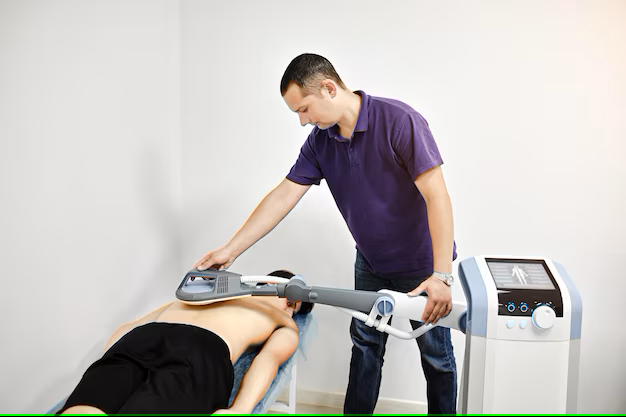Pain is something that many of us face at one point or another in life. Whether it’s a sore back from sitting too long, a stiff shoulder from lifting heavy items, or joint pain that makes daily activities difficult, it can be frustrating. However, there’s hope—there’s a method that might just bring you relief: Shockwave therapy.
If you’ve never heard of shockwave therapy or you’re curious about how it can help with pain relief, you’re in the right place. This blog will walk you through everything you need to know about how chiropractors in The Villages use shockwave therapy to help their patients live pain-free lives.
What Is Shockwave Therapy?
Shockwave therapy is a non-invasive treatment used to relieve pain and promote healing in muscles, tendons, and joints. It’s often used for patients dealing with chronic pain or conditions like plantar fasciitis, tendinitis, or even musculoskeletal injuries.
The treatment involves sending sound waves to the affected area of the body. These high-energy waves help stimulate blood flow, break up scar tissue, and promote tissue repair. Shockwave therapy has been used for many years and is known to be effective for treating a variety of musculoskeletal conditions.
What makes shockwave therapy so appealing to many patients is that it’s non-surgical. This means there’s no need for needles or invasive procedures. Plus, most people can return to their normal activities soon after treatment.
How Does Shockwave Therapy Work?
Shockwave therapy works by delivering high-energy pulses to the injured area. When these sound waves reach the tissue, they stimulate the body’s natural healing processes. The idea is to increase circulation to the damaged area, which helps speed up recovery.
Here’s a quick breakdown of the process:
- Application of Gel: A special gel is applied to the area where treatment will occur. This gel helps the shockwaves travel through the skin and reach the targeted tissues.
- Shockwave Application: The chiropractor uses a device that emits the shockwaves to the injured area. The treatment usually lasts around 10 to 15 minutes, depending on the size and location of the injury.
- Post-Treatment Care: After the treatment, most patients experience minimal discomfort. In some cases, you may experience mild soreness, but it generally goes away after a few hours or a day. Patients are often able to continue their normal activities with no downtime.
What Conditions Can Shockwave Therapy Help With?
Shockwave therapy is effective for a wide variety of musculoskeletal conditions. These include:
- Plantar Fasciitis: Pain in the heel of your foot, often caused by inflammation of the tissue that supports the arch of the foot.
- Tendinitis: Inflammation or irritation of a tendon, commonly seen in the elbow, shoulder, or knee.
- Chronic Back Pain: Persistent pain in the lower back that doesn’t go away with traditional treatments.
- Achilles Tendonitis: Pain and inflammation in the tendon that connects the calf muscles to the heel bone.
- Rotator Cuff Injuries: Injuries to the muscles and tendons around the shoulder joint.
- Knee Pain: Pain in the knee due to overuse, injury, or arthritis.
Shockwave therapy can also help with other issues like muscle stiffness, scar tissue, and even some types of joint pain. It’s important to consult with a professional like a The Villages chiropractor to see if shockwave therapy is right for you.
Why See a Chiropractor for Shockwave Therapy?
You may wonder why a chiropractor would be the right professional to deliver shockwave therapy. Chiropractors are trained to diagnose and treat musculoskeletal conditions. They focus on restoring alignment and function to the body, using hands-on techniques and specialized treatments like shockwave therapy.
Here are a few reasons why chiropractors in The Villages might be the best choice for your treatment:
- Comprehensive Assessment: Chiropractors take the time to evaluate your condition and determine the root cause of your pain. They don’t just treat the symptoms—they aim to improve your overall well-being.
- Non-Invasive Treatment: Chiropractic care, including shockwave therapy, is non-surgical. For many patients, this is a preferred option as it avoids the need for invasive surgeries or long recovery times.
- Customized Treatment Plans: Chiropractors create individualized plans based on your specific needs and goals. Whether it’s managing pain or improving mobility, shockwave therapy can be a key part of a well-rounded treatment plan.
- Natural Healing: Chiropractors focus on enhancing the body’s ability to heal itself. Shockwave therapy helps to stimulate the body’s natural healing process without relying on medications or invasive procedures.
The Benefits of Shockwave Therapy
Shockwave therapy offers several benefits that make it an appealing treatment option for those suffering from chronic pain. Some of the key benefits include:
- Quick Recovery: Because it’s a non-invasive treatment, recovery time is minimal. Most people can resume their normal activities right after the session.
- Effective for Chronic Conditions: Shockwave therapy is especially beneficial for those dealing with long-term or chronic pain. It can help break the cycle of inflammation, repair damaged tissue, and improve function.
- Non-Surgical Option: For people who want to avoid surgery or invasive treatments, shockwave therapy offers a safe and effective alternative.
- Reduced Need for Pain Medications: By stimulating the body’s healing process and addressing the root cause of pain, shockwave therapy can reduce the need for prescription pain medications or over-the-counter painkillers.
- Improved Mobility: One of the main goals of shockwave therapy is to improve joint function and mobility, so it can be particularly helpful for those with joint pain or stiffness.
What Should You Expect from Shockwave Therapy?
The first step in receiving shockwave therapy is to schedule a consultation with a chiropractor. During your visit, the chiropractor will perform a physical exam and ask about your medical history and symptoms. They will likely use imaging tests, like X-rays or ultrasound, to understand the extent of the injury or condition.
Once your chiropractor has determined that you are a good candidate for shockwave therapy, the treatment process will begin. The treatment itself is usually well-tolerated, and many patients report feeling only a mild discomfort during the procedure.
After your session, your chiropractor may recommend specific stretches or exercises to improve flexibility and prevent future injuries. It’s important to follow these instructions to get the best results from your treatment.
Is Shockwave Therapy Right for You?
While shockwave therapy can be highly effective, it’s not for everyone. Certain conditions, such as pregnancy, blood clotting disorders, or certain types of cancer, may prevent you from undergoing this treatment. It’s important to have a conversation with a qualified chiropractor to determine if shockwave therapy is a suitable option for your specific needs.
If you’re looking for pain relief and have been struggling with a chronic condition, shockwave therapy might just be the solution you need. By visiting a professional chiropractor like the team at Legacy Clinic of Chiropractic, you can explore whether shockwave therapy could be the key to relieving your pain and improving your quality of life.
Final Thoughts
Shockwave therapy is a non-invasive, effective treatment option for individuals suffering from chronic pain or musculoskeletal injuries. When performed by an experienced chiropractor, it can help promote healing, reduce inflammation, and improve mobility. Whether you’re dealing with back pain, tendonitis, or other joint issues, shockwave therapy could be just what you need to get back to living pain-free.
If you’re interested in learning more about how chiropractors in The Villages use shockwave therapy to treat pain, reach out to a local The Villages chiropractor today. They can help you assess your condition and decide if this treatment is the right fit for your healing journey.
Remember, your path to pain relief starts with one step, and shockwave therapy might be just that step.

